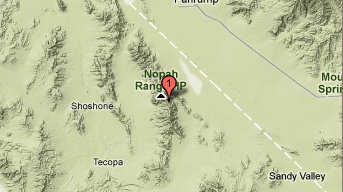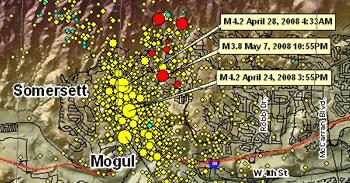- ▾ Other ShakeOuts ▾
- Alaska
- American Samoa
- Arizona
- British Columbia
- California
- Central U.S. (AL AR IA IL IN KS KY LA MO MS NE OH OK TN)
- CNMI
- Colorado
- Guam
- Hawaii
- Idaho
- Japan
- Montana
- Nevada
- New Mexico
- New Zealand
- NorthEast U.S. (CT MA ME NH NJ NY PA RI VT)
- Oregon
- Puerto Rico
- Quebec & Eastern Ontario
- SouthEast U.S. (DC DE FL GA MD NC SC VA WV)
- Texas
- Upper MidWest U.S. (MI MN ND SD WI)
- U.S. Virgin Islands
- Utah
- Washington State
- Wyoming
- Yukon
- Other Countries

Why Should You Participate?
While the potential earthquake hazards depend upon your location (see below), Nevada is considered at higher risk compared to most areas of the country. You could be anywhere when an earthquake strikes: at home, at work, at school or even on vacation.
What we do now will determine our quality of life after our next big earthquake. Are you prepared to survive and recover quickly?
The Great Nevada ShakeOut is an annual opportunity to practice how to be safer during big earthquakes: "Drop, Cover and Hold On." The ShakeOut has also been organized to encourage you, your community, your school, or your organization to review and update emergency preparedness plans and supplies, and to secure your space in order to prevent damage and injuries.
Learn more below, or read answers to frequently asked questions.
BENEFITS
Register today so that you or your organization will:
- Be counted in the largest-ever earthquake drill in Nevada!
- Be listed with other participants in your area (Optional)
- Be an example that motivates others to participate & prepare
- Be updated with ShakeOut news and preparedness tips
- Have peace of mind that you, your family, your co-workers and millions of others will be better prepared to survive and recover quickly from our next big earthquake!
EARTHQUAKE HAZARDS
Hazard Information for your ShakeOut Area:
Overview
Over the last 150 years, Nevada has ranked third in the country in the number of large earthquakes. Since the 1850s, 76 earthquakes with potentially destructive magnitudes of 5.5 or greater have occurred in Nevada. Nevada is earthquake country, and considering the number of earthquake generating faults located in the state, it is important to know how to prepare for an earthquake as well as how to take care during and after one hits.
Preparedness. University of Nevada, Reno.
Earthquakes are a part of Nevada’s natural history. The Earth’s crust is being pulled apart and wrenched sideways in Nevada, and much of this deformation is accompanied by earthquakes. In western Nevada, where the hazard is the highest in the state, most citizens have experienced small events every couple of years. Earthquakes have occurred less frequently in other parts of the state, and some people may not be aware of the earthquake threat. In 1954, east of Fallon, five earthquakes of magnitude 6 or greater (two of magnitude 7) occurred over a period of six months and strongly shook central Nevada. The most recent major earthquake occurred in 2008, near Wells, leaving 19 million dollars in damage.
Living with Earthquakes in Nevada. University of Nevada, Reno.
The State of Nevada is located in “earthquake country.” It lies within the Basin and Range Province, one of the most seismically active regions in the United States. Along with California and Alaska, Nevada ranks in the top three states subject to the most large earthquakes over the last 150 years.
Earthquakes in Nevada and How to Survive Them. University of Nevada, Reno.
Google Earthquake Location Map for Nevada and Eastern California (Nevada Seismological Laboratory)

Notable Earthquakes in Nevada (Nevada Seismological Laboratory)

Earthquakes in Nevada Preparedness Guides
WHY DROP, Cover, and Hold On?
Why is it important to do a Drop, Cover, and Hold On drill? To react quickly you must practice often. You may only have seconds to protect yourself in an earthquake, before strong shaking knocks you down--or drops something on you. Practicing helps you be ready to respond.
- If you are inside a building, move no more than a few steps, then Drop, Cover and Hold On:
- DROP to the ground (before the earthquake drops you!),
- Take COVER by getting under a sturdy desk or table, and
- HOLD ON to it until the shaking stops.
- If you are outdoors when the shaking starts, you should find a clear spot away from buildings, trees, streetlights, and power lines, then Drop, Cover and Hold On. Stay there until the shaking stops.
- If you are driving, pull over to a clear location, stop and stay there with your seatbelt fastened until the shaking stops. Once the shaking stops, proceed with caution and avoid bridges or ramps that might have been damaged.
Ground shaking during an earthquake is seldom the cause of injury. Most earthquake-related injuries and deaths are caused by collapsing walls and roofs, flying glass and falling objects. It is extremely important for a person to move as little as possible to reach the place of safety he or she has identified because most injuries occur when people try to move more than a short distance during the shaking.
Look around you now, before an earthquake. Identify safe places such as under a sturdy piece of furniture or against an interior wall in your home, office or school so that when the shaking starts you can respond quickly. An immediate response to move to the safe place can save lives. And that safe place should be within a few steps to avoid injury from flying debris.
Further information:



